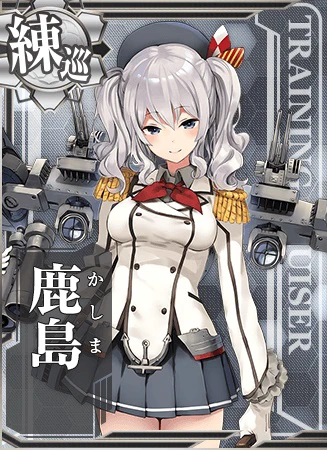- Armed when completed (1940)
- Arming in February (1945)
- NO

Classification: Training cruiser
Ship number: 73rd ship
Construction site: Mitsubishi Heavy Industries Yokohama Dock
Groundbreaking date: October 6, 1938
Completed: May 31, 1940
Retirement date: 1947
Origin of name: Kashima Shrine, Ibaraki Prefecture
Armament (at the time of completion)
50 caliber three-year type 14cm gun, 2 twin mounts, 4 guns
12.7cm twin high-angle gun, 2 guns
2 x 4 25mm twin machine guns
2x 53cm six-year twin launch tubes, 4 gates
4 six year type (53cm) torpedoes
Type 96 110cm searchlight modified 1 2 units
4 5cm salute guns
No depth charge weapons
Equipped with: 1 Type 0 water reconnaissance aircraft
1 Kure type 2 type 5 injection machine
Equipped with boats: 2 12m internal fire boats, 3 12m internal fire launchers, 2 9m cutters, 1 6m transit boat
Armed (1945)
50 caliber 14cm twin guns, 2 groups, 4 guns
Secondary guns/guns: 40 caliber 12.7cm twin high-angle guns, 3 groups, 6 guns
Machine gun: 4 x 12 25mm triple machine guns
25mm single machine gun: 4 groups, 8 groups
25mm single machine gun: 18 groups 18 guns
Electric search No. 21 anti-aircraft electric search: 1 unit
No. 13 anti-aircraft electric search: 1 unit

Construction history
After 1916, the Japanese Navy used old-style armored cruisers (Iwate, Izumo, etc.) for long-distance voyages for cadets. However, due to aging and diversion of ships, the number of ships was reduced to two by 1935. In addition, in 1938, in order to cope with the increasing number of Naval Academy graduates, plans were made to equip the Navy with a cruiser specialized in training ship duties. Initially, three ships were included in the ③ plan, but only two (Katori and Kashima) were approved. Later, one ship (Kashii) was added in the ④ plan, and another one (Kashihara) was added in 1941.
history
On June 1, Kashima was deployed to the training fleet along with the first ship, Katori. From August 7th, she will depart on an ocean voyage. However, due to changes in the situation, she completed only her first voyage on September 20th. This was the Imperial Navy’s last ocean voyage.
On November 15, Kashima, a newly built ship with ample officer quarters, became the flagship of the 4th Fleet. Belongs to 18th Squadron (Kashima, Light Cruiser Tenryu, Tatsuta)
In early February 1941, she participated in a large-scale exercise held off the coast of Kochi. On February 3, she became the target of the battleship Hiei’s gunfire.
From mid-October to late October, the ships of the 4th Fleet gathered at Truk anchorage. On December 1st, the 4th Fleet Headquarters became independent, and Kashima became her sole flagship.
After the war began, Kashima had no opportunity to participate in important naval battles on the front lines due to its lack of speed and armament. For this reason, she often took command as a headquarters until she was relieved of her position as 4th Fleet flagship in November 1943.
After being released, Kashima returned to Japan and spent about a year in the Inland Sea, where he was in charge of boarding training for Naval Academy students.
In 1944, Kashima unloaded torpedoes and added high-angle guns, machine guns, and depth charges to boost maritime transport, which had been neglected towards the end of the war.
From January 1, 1945, she served as flagship of the 102nd Squadron in the 1st Escort Squadron for convoy escort. She mainly escorted routes between mainland Japan and mainland China.
On May 19th, she collided with the cargo ship Daishin Maru off the coast of Geoje Island, and Kashima suffered minor damage to her bow and underwent emergency repairs at Jinhae. After leaving the 102nd Squadron and entering Maizuru to complete repairs, she moved to Nanao Bay with the coastal defense ships Takane, Urugu, and Chikuo to command anti-submarine and minesweeping operations in the northern Sea of Japan from Hokuriku to Tohoku. The war ended in August.
After the end of the war, Kashima was still in good health without any damage, so she was used as a special transport ship to transport demobilized soldiers along with Hosho, Katsuragi, and others who had also reached the end of the war.
She was then dismantled at Kawaminami Kogyakijima Shipyard between November 12, 1946 and June 15, 1947.
Aside: Queen of Ariake
The name comes from KanColle’s Kashima, which was introduced in the Fall 2015 event, and immediately became a supernova in the KanColle doujinshi in the Winter 2015 comic. I’m sure you’ve all seen it somewhere. Furthermore, Ariake is Ariake, Koto Ward, Tokyo, which is the address of the Tokyo International Exhibition Center, so it has nothing to do with the Ariake Sea.

photograph


sauce
https://連合艦隊ww2.jp/warship04026.htm
http://www.combinedfleet.com/kashima_t.htm


